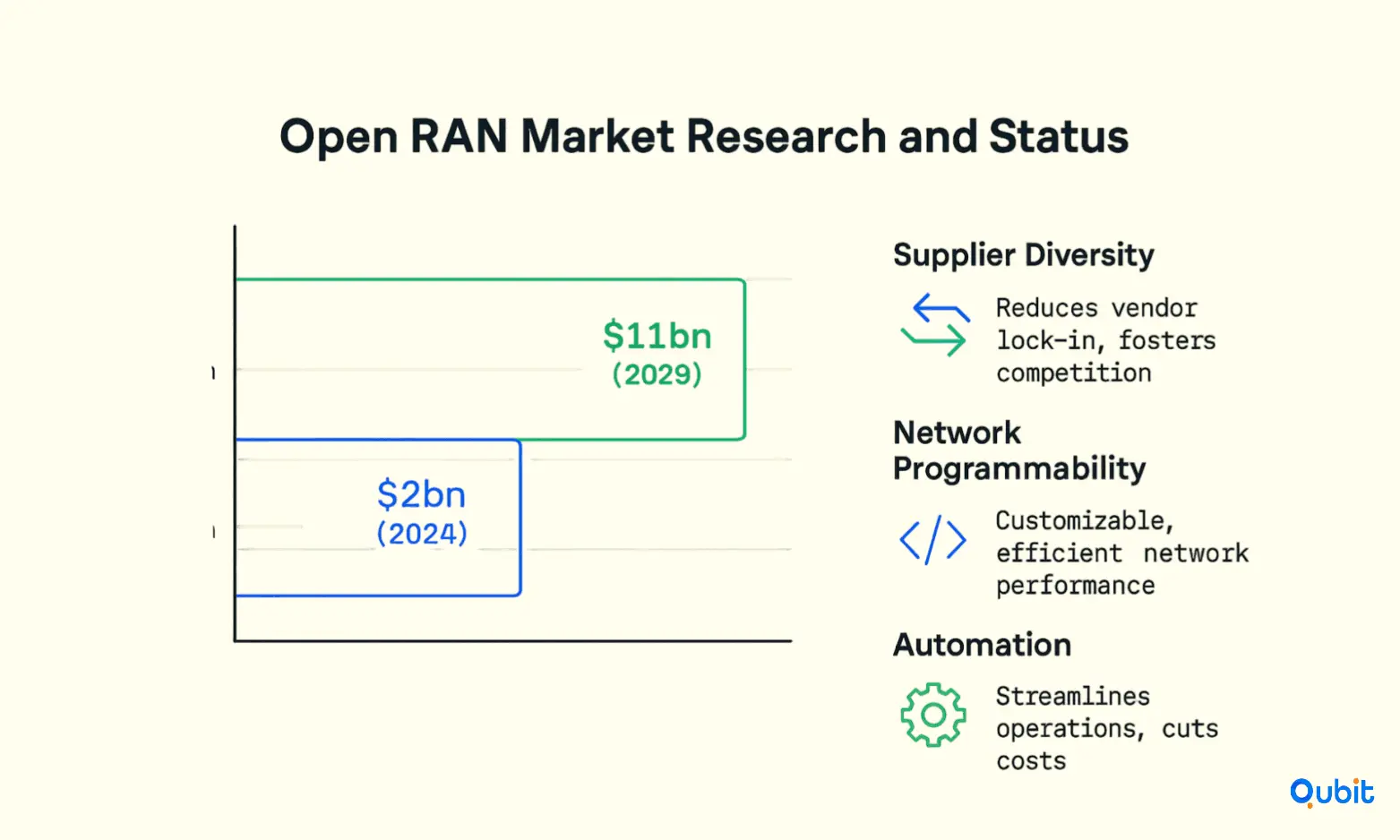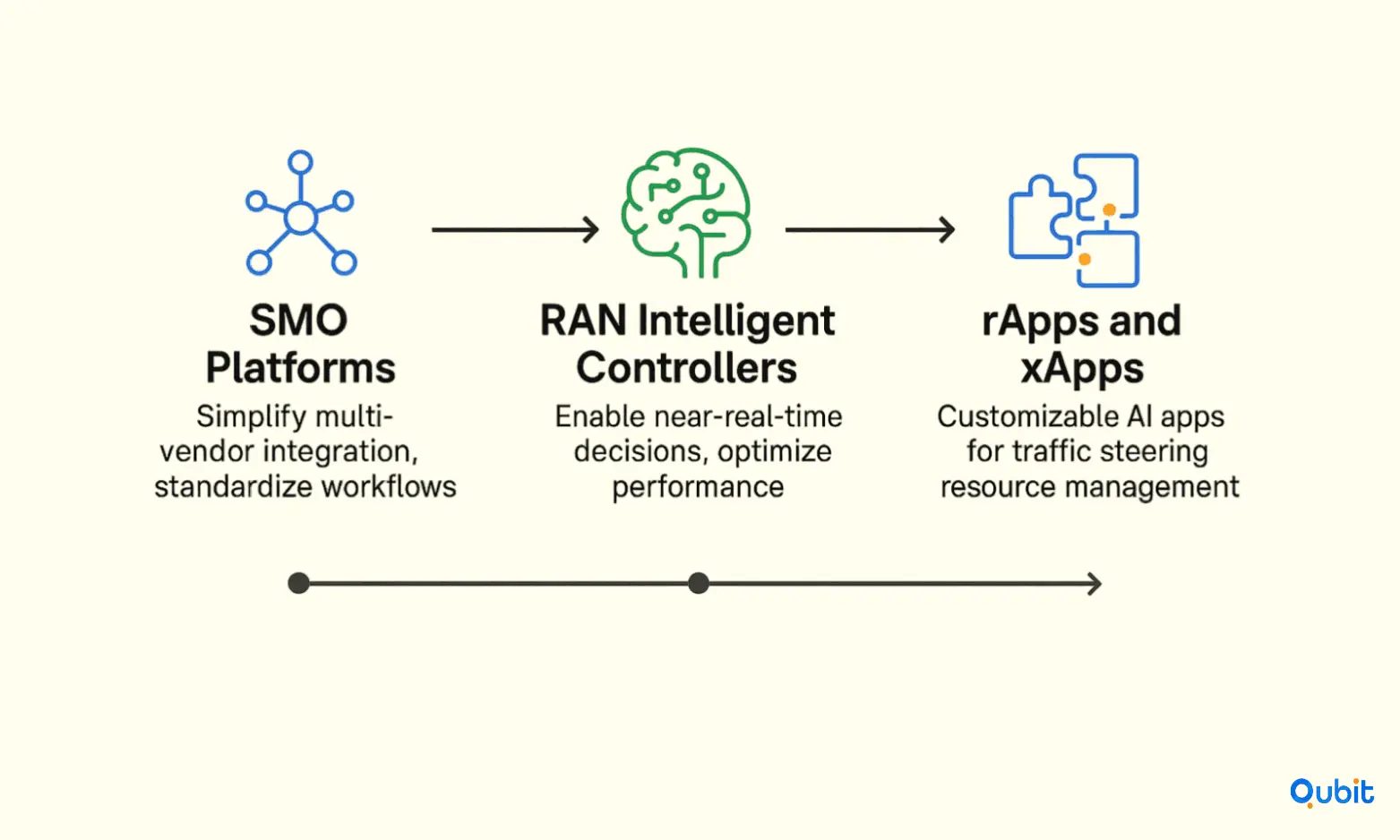The rapid evolution of 5G technology and Open RAN architecture is reshaping the telecom industry, presenting significant investor opportunities. With operator investments projected to surge from $2 billion to $11 billion, the market is poised for exponential growth. This shift is driven by the demand for scalable, cost-effective solutions that enhance network performance and flexibility.
Your exploration of the 5G and Open RAN landscape is complemented by the analysis in how to secure funding for telecom startups, which lays the groundwork for understanding broader financial strategies in telecom investments.
This blog delves into the data-driven insights behind these trends, offering a closer look at the investment potential in this transformative sector. Let’s jump right in!
Open RAN Market Research and Status
The Open RAN market is undergoing a transformative phase, with operator investments expected to surge from $2bn in 2024 to an impressive $11bn by 2029. This rapid growth reflects a shift from initial enthusiasm to a focus on practical drivers such as supplier diversity, network programmability, and automation. These factors are reshaping how operators approach their network strategies, emphasizing flexibility and innovation.

Operator Investments and Market Growth
Annual operator investments in Open RAN are set to rise sharply, starting at $2bn by the end of 2024. This upward trajectory highlights the increasing confidence in Open RAN's potential to revolutionize network infrastructure. By 2029, this figure is forecasted to reach $11bn, underscoring the long-term commitment of operators to this technology. Such growth is not just about scaling networks but also about embracing a more open and collaborative ecosystem.
Key Drivers of Adoption
The adoption of Open RAN is being fueled by several critical factors. Supplier diversity has emerged as a cornerstone, enabling operators to reduce dependency on a single vendor and foster a competitive environment. Additionally, network programmability is allowing operators to tailor their networks to specific needs, enhancing efficiency and performance. Automation, another significant driver, is streamlining operations and reducing costs, making Open RAN an attractive option for operators worldwide.
The Role of Spectrum Refarming and Refresh Cycles
Industry events and discussions have highlighted the importance of spectrum refarming and operator refresh cycles in accelerating Open RAN adoption. As operators look to optimize their existing spectrum assets and upgrade aging infrastructure, Open RAN offers a flexible and cost-effective solution. These cycles provide a natural opportunity for operators to integrate Open RAN into their networks, further driving its adoption.
The Open RAN market is not just about technology; it's about creating a dynamic and competitive ecosystem that benefits operators, suppliers, and end-users alike. With investments and innovations on the rise, the future of Open RAN looks promising.
Open RAN Investments and Market Trends
The investment landscape for Open RAN automation is undergoing a remarkable transformation. What began as cautious early-stage funding is now shifting toward aggressive capital allocation, driven by operator confidence and promising market forecasts. With Open RAN automation investments projected to grow from approximately $50 million today to nearly $700 million annually by 2027, the sector is poised for exponential expansion.
Accelerating Growth and Operator Confidence
A compound annual growth rate (CAGR) exceeding 125% between 2024 and 2027 underscores the increasing interest from telecom operators in next-generation automation solutions. This surge reflects a strategic pivot, as operators allocate capital to technologies that promise scalability, efficiency, and enhanced network performance. The forecasted rise in Open RAN automation investments aligns with broader trends in the telecom sector, where financial commitments are intensifying.
Market Expansion and Future Projections
The Open RAN market is set to experience unprecedented growth, with investment forecasts predicting a leap from $2 billion in 2024 to $11 billion by 2029. This surge in financial activity highlights the growing confidence in Open RAN’s ability to redefine network infrastructure and automation capabilities. For a deeper understanding of how these trends complement adjacent developments, explore emerging telecom investment trends.
As operators continue to prioritize automation, the Open RAN ecosystem is expected to evolve rapidly, unlocking new opportunities for innovation and collaboration. This trajectory not only signals robust market expansion but also positions Open RAN as a cornerstone of future telecom advancements.
Key Technologies in Open RAN Automation
The evolution of Open RAN (Radio Access Network) is transforming the telecommunications landscape, with automation playing a pivotal role in its success. At the heart of this transformation are technologies like Service Management and Orchestration (SMO) platforms, RAN Intelligent Controllers (RICs), and programmable applications such as rApps and xApps. These innovations are redefining how networks operate, optimize, and adapt in real time.

SMO Platforms: Simplifying Integration
Service Management and Orchestration (SMO) platforms are the backbone of Open RAN automation. They enable vendor-agnostic integrations, allowing operators to reduce operational complexities and accelerate their time to market. By standardizing interfaces and workflows, SMO platforms ensure seamless communication between diverse network components. This capability is particularly valuable in multi-vendor environments, where interoperability challenges can otherwise hinder efficiency.
RICs: Enabling Adaptive Networks
RAN Intelligent Controllers (RICs) bring near-real-time adaptability to Open RAN systems. These controllers are essential for meeting the ultra-low latency demands of 5G networks. By analyzing network conditions and making split-second decisions, RICs optimize resource allocation and improve overall performance. For instance, Samsung accelerates Open RAN development in collaboration with industry partners, emphasizing the importance of interoperability protocols within RICs. This highlights how RICs are central to achieving dynamic and responsive network operations.
rApps and xApps: Customizing Network Functions
Programmable applications like rApps and xApps empower operators to tailor network functions to their specific needs. These modular applications leverage AI and machine learning to streamline resource allocation and enhance performance management. A prime example is AI-based traffic steering, which automates the routing of cellular traffic to maximize network resources. This real-time xApp not only improves RAN performance but also enhances the user experience.
For those exploring adjacent technologies that complement Open RAN innovation, insights into iot connectivity funding provide a focused perspective on niche investment areas.
By integrating these key technologies, Open RAN automation is paving the way for smarter, more efficient networks capable of adapting to the ever-evolving demands of modern connectivity.
Benefits of Open RAN Automation
Adopting Open RAN automation brings a host of advantages that transform network operations. From enhancing energy efficiency to driving down costs, the benefits are both tangible and impactful.
Improved Energy Efficiency
One of the standout benefits of Open RAN automation is its ability to optimize energy consumption. AI-driven automation enables dynamic power adjustments, ensuring that idle network cells consume minimal energy. This not only reduces operational costs but also aligns with sustainability goals by lowering the carbon footprint of network operations.
Cost Reduction Through Unified Platforms
Streamlining operational management becomes significantly easier with unified orchestration platforms. These platforms can reduce Total Cost of Ownership (TCO) by up to 30%, simplifying maintenance and minimizing the need for manual interventions. The result is a more cost-effective and efficient network infrastructure.
Enhanced Network Performance
Automation in Open RAN also leads to improved overall network performance. By automating routine tasks and optimizing resource allocation, networks can deliver better service quality and reliability. This ensures a seamless experience for end-users while reducing the likelihood of service disruptions.
Open RAN automation is not just a technological upgrade; it’s a strategic move toward smarter, more sustainable network management.
Case Studies and Operator Deployments
Open RAN deployments are transforming the telecommunications industry, with global operators adopting diverse strategies to unlock technical and economic benefits. From multi-vendor integrations to groundbreaking partnerships, these deployments showcase the adaptability and innovation of Open RAN solutions.
NTT Docomo: Leading the Charge in Japan
NTT Docomo has emerged as a frontrunner in Open RAN adoption, integrating automated network solutions to enhance operational efficiency. By embracing multi-vendor setups, the operator has demonstrated how Open RAN can reduce costs while maintaining high performance standards. This approach highlights the scalability of Open RAN for large-scale networks.
Vodafone's Collaborative Innovations
Vodafone has been actively exploring Open RAN through strategic collaborations. For instance, the partnership with i2CAT has resulted in the development of advanced Open RAN management platforms. This project exemplifies commercial-level innovation, showcasing how operators can refine network management systems to meet evolving demands. Vodafone and i2CAT have set a benchmark for integrating novel solutions into existing frameworks.
Additionally, Vodafone's collaboration with Nokia in Italy has yielded a successful 5G standalone Open RAN trial. This deployment underscores the potential of Open RAN in delivering next-generation connectivity while fostering partnerships between established OEMs and operators. Learn more about this milestone through Nokia and Vodafone complete a 5G standalone trial.
AT&T and Telus: North American Success Stories
In North America, AT&T and Telus have validated the technical merits and economic advantages of Open RAN. AT&T's focus on automation has streamlined network operations, while Telus has leveraged Open RAN to improve scalability and reduce vendor lock-in. These case studies illustrate the versatility of Open RAN across different market conditions.
Global operators are proving that Open RAN is more than a concept—it’s a practical solution for modern network challenges. By adopting varied strategies, they are paving the way for a more flexible and cost-effective telecommunications landscape.
Challenges and Future Outlook
The adoption of Open RAN technology is reshaping the telecommunications industry, but its path to widespread implementation is not without obstacles. Among the most pressing Open RAN challenges are issues of interoperability and scalability, which demand innovative solutions to ensure seamless integration across multi-vendor networks.
Tackling Interoperability
Interoperability remains a critical hurdle for Open RAN, as the technology relies on components from multiple vendors working together harmoniously. Without common standards and robust test environments, achieving this level of integration can be difficult. Industry initiatives like the Digital Catapult testing initiative for Open RAN are actively addressing this challenge. This program invites suppliers to explore Open RAN feasibility, fostering collaboration and creating a framework for smoother multi-vendor integration.
Scalability and Market Growth
Scalability is another challenge that Open RAN must overcome to meet the demands of large-scale deployments. As networks expand, ensuring consistent performance across diverse environments becomes increasingly complex. However, despite these hurdles, the future of Open RAN looks promising. Market projections indicate a compound annual growth rate (CAGR) exceeding 125%, underscoring the technology's immense potential. This optimistic outlook reflects growing confidence in Open RAN's ability to transform the telecommunications landscape, driven by advancements in testing, standardization, and vendor collaboration.
Open RAN’s challenges are significant, but the industry’s commitment to innovation and collaboration is setting the stage for transformative growth.
AI-Driven Network Optimization
AI technologies are playing a pivotal role in enhancing telecom operations. From predictive analytics to automated network management, AI in telecom is enabling smarter, more efficient systems. Resources that delve into AI's integration within telecom provide valuable perspectives on how these advancements complement Open RAN's modular and flexible architecture.
5G Innovation and Competitive Dynamics
The rapid evolution of 5G networks continues to redefine connectivity standards. By examining resources focused on 5G innovation, you can uncover how Open RAN aligns with the broader push for faster, more reliable, and scalable networks. These insights also shed light on the competitive strategies telecom providers are adopting to stay ahead in the 5G race.
The Evolution of Telecom Services
Telecom services are undergoing a significant transformation, driven by technological advancements and shifting consumer demands. Resources that explore this evolution provide a comprehensive view of how Open RAN fits into the larger narrative of telecom modernization.
By engaging with these resources, you can gain a holistic perspective on the interconnected trends shaping the telecom industry, enriching your understanding of Open RAN's role in this dynamic ecosystem.
Conclusion
The transformative potential of Open RAN investments cannot be overstated. With market projections highlighting rapid growth and the undeniable technological advantages, the opportunities for investors are immense. Throughout this blog, we’ve explored key strategies and insights to help you capitalize on this evolving sector. From understanding market dynamics to identifying growth drivers, the path forward is clear for those ready to act.
If you're looking to connect with the right investors, our Investor Discovery and Mapping service at Qubit Capital can bridge that gap. Let’s get started.
Key Takeaways:
- Open RAN investments are poised to surge from $2 billion to $11 billion, indicating robust market growth.
- Automation in Open RAN can yield significant total-cost-of-ownership reductions and energy savings.
- Key technologies like SMO, RICs, and rApps/xApps are driving network innovation.
- Global case studies underscore the operational and economic benefits of Open RAN deployments.
- Despite challenges, the future outlook for Open RAN remains highly promising.
Frequently asked Questions
What is Open RAN in 5G?
Open RAN refers to a disaggregated, software-defined approach to building radio access networks. It promotes vendor diversity, enhances interoperability, and enables automation in 5G deployments.


 Back
Back



